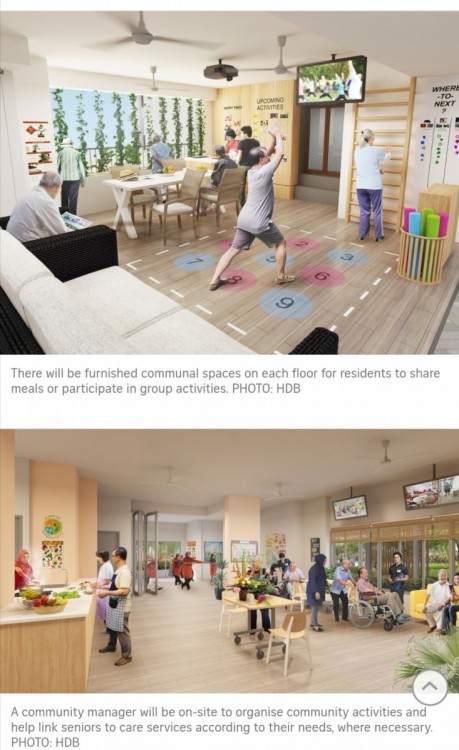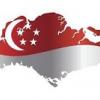Search the Community
Showing results for tags 'Housing'.
-
I'm looking to change my bank home loan. (private housing) based on today's interests rate, anyone can recommend a bank who can offer a better deal? Income level and other criteria, sure meet the requirements. Loan amt, only $930k Current bank is UOB on FD rate package.
-
https://www.channelnewsasia.com/news/singapore/164-000-singaporean-adults-living-in-private-housing-have-no-11513318 Hmm... pity, empathy or disgust?
-
https://www.straitstimes.com/singapore/housing/singapores-first-assisted-living-hdb-flats-for-seniors-to-launch-in-bukit-batok SINGAPORE - Singapore's first assisted living public housing in Bukit Batok for seniors who wish to live on their own and yet enjoy some care, support and communal activities will be launched for sale in next February's Build-To-Order (BTO) exercise. The new flat typology comes with a mandatory service package to support seniors to age in place, said the Ministry of National Development (MND), Housing Board (HDB) and Ministry of Health (MOH) in a joint statement on Thursday (Dec 10). Services under the package include 24-hour emergency monitoring and response service, basic health checks, simple home fixes and activities at the communal spaces within the development. All residents will have to subscribe and pay for the basic service package, which starts from $22,000 for a 15-year lease. Other services such as housekeeping, laundry, meal delivery and shared caregiving can be added on at an additional cost. Located in Bukit Batok West Avenue 9, the pilot batch of Community Care Apartments comprises about 160 units and is expected to be completed in 2024. The flats were scheduled to be launched in May but were delayed due to the Covid-19 pandemic. Each 32 sq m flat comes with senior-friendly fittings including grab bars and wheelchair-accessible bathroom with slip-resistant flooring to allow residents to move around their homes with ease. The flats have an open layout and come with sliding partitions to separate the living room and bedroom, along with a built-in wardrobe, cabinets and furnished kitchen to reduce renovation time. There will be furnished communal spaces on each floor for residents to share meals or participate in group activities, which serve as "extensions of their own living rooms", said the agencies. A community manager will be on-site to organise community activities and help link seniors to care services according to their needs, where necessary. Residents will also get priority for admission to the nearby Bukit Batok Care Home, should the need arise in the future. Other amenities within the development include a precinct pavilion, strolling path, activity centre, hawker centre, community garden and fitness station. Singapore's first assisted living HDB flats for seniors to launch in Bukit Batok in Feb 2021 BTO exercise The new flat typology comes with a mandatory service package to support seniors to age in place.PHOTOS: HDB Michelle Ng PUBLISHED 1 HOUR AGO FACEBOOKWHATSAPP SINGAPORE - Singapore's first assisted living public housing in Bukit Batok for seniors who wish to live on their own and yet enjoy some care, support and communal activities will be launched for sale in next February's Build-To-Order (BTO) exercise. The new flat typology comes with a mandatory service package to support seniors to age in place, said the Ministry of National Development (MND), Housing Board (HDB) and Ministry of Health (MOH) in a joint statement on Thursday (Dec 10). Services under the package include 24-hour emergency monitoring and response service, basic health checks, simple home fixes and activities at the communal spaces within the development. All residents will have to subscribe and pay for the basic service package, which starts from $22,000 for a 15-year lease. Other services such as housekeeping, laundry, meal delivery and shared caregiving can be added on at an additional cost. Located in Bukit Batok West Avenue 9, the pilot batch of Community Care Apartments comprises about 160 units and is expected to be completed in 2024. The flats were scheduled to be launched in May but were delayed due to the Covid-19 pandemic. Each 32 sq m flat comes with senior-friendly fittings including grab bars and wheelchair-accessible bathroom with slip-resistant flooring to allow residents to move around their homes with ease. The flats have an open layout and come with sliding partitions to separate the living room and bedroom, along with a built-in wardrobe, cabinets and furnished kitchen to reduce renovation time. There will be furnished communal spaces on each floor for residents to share meals or participate in group activities, which serve as "extensions of their own living rooms", said the agencies. A community manager will be on-site to organise community activities and help link seniors to care services according to their needs, where necessary. Residents will also get priority for admission to the nearby Bukit Batok Care Home, should the need arise in the future. Other amenities within the development include a precinct pavilion, strolling path, activity centre, hawker centre, community garden and fitness station. Other amenities within the development include a hawker centre. PHOTO: HDB The pilot batch of Community Care Apartments comprises about 160 units and is expected to be completed in 2024. PHOTO: HDB Seniors must be 65 and above to apply for these flats. They will be able to choose a lease ranging from 15 to 35 years, in five-year increments, as long as it covers the applicant and their spouse, if any, until they are at least 95 years old. Prices for these flats start from $40,000 for a 15-year lease to $65,000 for a 35-year lease, and are required to be paid for fully upfront with cash or with Central Provident Fund (CPF) monies. Government subsidies such as the Silver Housing Bonus, which gives seniors up to $30,000 cash bonus when they sell their existing flat and use the proceeds to top-up their CPF Retirement Account, are applicable. However, these flats cannot be resold or rented out. Owners who no longer need the flat can return the flat to the HDB, which will refund them the value of the remaining lease of the flat. Seniors with more pressing care needs, such as those requiring permanent assistance with activities of daily living, will be prioritised for the flats. From next Monday to March 31, 2021, seniors and members of the public will be able to visit a life-sized showcase of the communal space, along with scale models of the block and flat, at the HDB Hub atrium at Lorong 6 Toa Payoh. A showroom of the flat will open from Jan 4, 2021. Visitors must book an appointment via HDB InfoWeb before visiting the exhibition.
-

Drunk truck driver nearly sends tree flying into HDB flat!
chitchatboy posted a blog entry in MyAutoBlog
Now we bet the the driver of this truck will be regretting really hard about driving after having some drinks. Spotted on Beh Chia Lor's Facebook page and some of our Whatsapp group chats, is this video of a trailer truck crashing into an HDB block at Block 152 Yung Ho Road. It happened on 16 Nov 2020. Thankfully, the tree that the truck knocked down managed to stop it from crashing into one of the first level HDB unit. Rest In Peace, tree... The truck driver has since been arrested for drunk driving. Netizens' comments were naturally not kind to the truck driver... 34c5433d-4976-4664-8e03-ca6af42dface.MP4 -
hope the poll works
-
NDR 2018: Scheme planned to redevelop more old HDB flats before leases end source: https://www.channelnewsasia.com/news/singapore/ndr-2018-scheme-planned-to-redevelop-more-old-hdb-flats-before-10631458
-
more like propose … since they can't really launch anything … (disclaimer : this post is not politically motivated) SDP launches housing programme: Non-open market flats to solve the problem of depreciating value of HDB flats Under the programme proposed by SDP, administrative, material, and labour costs will still be included in the price of new HDB apartments, but the land cost will not, resulting in considerably lower prices Singapore Democratic Party (SDP) launched its housing policy on Saturday, April 6, with the proposal for Non-Open Market (NOM) flats to be introduced to the public housing system to address HDB’s 99-year lease crisis. At at the SDP office in Ang Mo Kio, the party’s leaders explained that NOM apartments are those which do not include land costs in their price. The policy, entitled Housing A Nation: Holistic Policies For Affordable Homes, was presented by Party Vice-Chairman John L. Tan, and Treasurer Bryan Lim. They explained that this programme would address the problem of the depreciating value of HDB flats because of the 99-year lease of the land. At the launch, Mr Tan said, “Depreciating values, especially of ageing flats, mean that owners cannot depend on their flats as a nest-egg. The problem is compounded by the fact many Singaporeans have depleted their CPF savings to pay for their flats.” Under the programme proposed by SDP, administrative, material, and labour costs will still be included in the price of new HDB apartments, but the land cost will not. This will result in considerably decreased prices for flats, for example, 2-room apartments would cost around S$70,000, and 5-room flats could cost lower than S$240,000. Bryan Lim pointed out that “As the name implies, however, flats bought under this scheme will not be allowed to be re-sold in the open market,” and that people who wanted to sell their flats would have to sell them again to the HDB. He pointed out that for public housing, the Government should not make a profit from citizens, and that citizens should not use their HDB flats for capital gain. He asserted that as a social good, public housing must be utilized for meeting the ends of the people, and not for profit for either the government or homeowners. According to a statement from the SDP, under the NOM scheme, Singaporeans would only take 9-15 years to pay off their housing loans, given a 3 percent interest rate and using no more than 20 percent of gross income. The SDP says that this reduces the burden on citizens buying homes and that it would free up funds for greater retirement savings. Part of the SDP’s proposal is for existing homeowners to convert their flats under the NOM scheme, which would entail the Government giving back the difference between “between the original price of their flats (as purchased from the HDB) and price of an equivalent NOM flat subject to a cap,” the press statement said. Afterward, the difference would be credited to the homeowner’s CPF or would go toward existing housing loans. “The NOM scheme essentially gives Singaporeans an added option of buying a home at a greatly reduced price. First-time HDB buyers can choose to buy an open market or non-open market flat.”
-
Is the HDB housing loan a reducing balance loan? If so, how is the monthly instalment amount calculated? I understand that if the monthly instalment is X, then X = Y+Z where Y goes toward principal and Z toward interest. Over time, X remains constant but Y and Z will change. How is X determined? How are the proportions of Y and Z determined? attached: example using CPF website calculator
-
we heard of * toufu dreg projects in overseas construction i am sure our authorities are extremely vigilant to prevent such things from happening in singapore anyone in the construction industry can share how quality & safety control are conducted for projects in singapore touchwood so far so good none of such nonsense found in singapore * https://en.wikipedia.org/wiki/Tofu-dreg_project
- 4 replies
-
- 1
-

-
- housing
- construction
-
(and 3 more)
Tagged with:
-
This was brought up a few days ago, in the "President" 's policy suggestions... Instead of stopping people using their CPF to pay for their mortgages, why not reduce the prices if HDB flats and not peg them to market prices with land prices? Then Singaporeans will have more money to save with lower HDB flats prices. What Would Happen if You Couldn't Use Your CPF Savings to Buy a Home? https://sg.finance.yahoo.com/news/happen-couldn-apos-t-cpf-213202807.html In response to President Halimah's call for policy suggestions, economist Walter Theseira suggested disallowing the use of CPF savings for home purchases. The measure was proposed in order to address inadequate retirement saving. This could be a logical concern, as putting a significant amount of one's retirement into home may leave them with too few remaining assets to retire comfortably, especially given the uncertainties around the 99-year HDB lease. This proposal would likely have a massive impact on the housing market—over the past decade, around S$82 billion was withdrawn from CPF accounts in order to purchase HDB flats. Given the scale of this proposal, it is worth asking: how would homeowners and prospective homebuyers be affected? How Does The Current System Work? Currently, the Public Housing Scheme (PHS) allows individuals to use their CPF Ordinary Account to pay for a part of their HDB flat purchase. However, homebuyers are limited in the amount that they can withdraw from their CPF savings for the purchase of a HDB lease. Limits are based on the number of years remaining in the lease at the time it is purchased. How Would This Proposal Affect the Real Estate Market? In the short-term, we expect that housing prices would drop as result of proposed rule. The rule will likely prevent many prospective homeowners from being able to afford to purchase homes, as they would have significantly less money to contribute to the purchase. The decreased ability to buy a property should lead to a decline in market demand, which should in turn cause a decrease home prices. For example, we can approximate the scale of change with some basic calculations. In 2017, $7.4 billion was withdrawn for the purpose of purchasing new and resale HDB flats. There were 22,077 resale applications and approximately 17,500 new units in 2017. Assuming average resale values of S$450,000 and average BTO prices of S$310,000, the S$7.4 billion withdrawn in 2017 represents about half (48%) of the total HDB market transactions (S$15.4 billion). Although these are rough estimates, roughly 20% of this might be supporting the actual home value, while the other 30% is being used to pay interest on home loans. In the long run, it seems reasonable to expect that HDB prices could drop by 10-20% as developers acquiesce to consumers' reduced purchasing power while prospective buyers take longer to build enough savings to buy a flat. Good News for Prospective Home Buyers? Overall, this proposal appears that it would be a net-neutral event for prospective home buyers. On one hand, these individuals may have to save longer in order to purchase a home since they will not be able to access their CPF savings. On the other hand, a drop in housing prices could offset their reduced ability to purchase homes. Additionally, these individuals will benefit from having additional retirement savings since their CPF will be able to compound untouched over a long period of time. Bad News for Existing Homeowners However, this proposal definitely could have a negative impact for current property owners. If all buyers in the market are less able to afford current real estate prices, the market forces tend to adjust the prices lower until people can afford flats without the help of their CPF accounts. This would ultimately mean a reduction of wealth for those who already own HDB flats. Additionally, current homeowners may face another negative consequence. Currently, individuals re-selling their HDB flats must refund their CPF account based the principal amount withdrawn for their HDB flat purchase, as well as the amount of accrued interest that the savings would have earned if they had not withdrawn from the CPF account initially. If property values drop significantly, these homeowners will have much more difficult time meeting this refund requirement. How to Make a Smooth Transition The proposal would certainly incentivize increased personal savings and promote wealthier retirement, which could be a financially responsible goal. In order to make this transition easier, however, there are a few concepts to consider. First, because existing homeowners must refund their CPF account based on the amount withdrawn for purchasing a home, declining home prices could put them at significant financial risk. One way to make the proposed rule more palatable would be to decrease the refund requirements for current homeowners. Additionally, if HDB leases were extended, policy makers might be able to both buoy short-term home prices as well as mend a long-term structural issue related to HDBs. It could also help the owners of older flats, whose retirement savings could benefit from increased resale value if leases were easily extended beyond 99 years. ____________________________________________________________________________________________________________ The truth behind proposal to prevent CPF for housing https://sg.finance.yahoo.com/news/truth-behind-proposal-prevent-cpf-065043359.html An academic’s suggestion which seemed to propose that the Central Provident Fund (CPF) monies no longer be allowed to be used to buy residential properties, has in recent days stirred the hornet’s nest. Walter Theseira, professor of Economics at UniSIM, made that suggestion in responding to President Halimah’s call for policy suggestions. Prof Dr Theseira said that the use of CPF savings for housing should be curbed in a bid to prevent the people from over-investing their savings on housing. He noted that people typically over-invest on housing as a way of “unlocking their CPF funds” and that installing measures to limit the use of CPF monies for housing could help the people conserve their savings for retirement and health. He said: “My view is that the CPF system tries to do a little too much, and we should consider focusing CPF on retirement and health…I do believe there is some over-investment in housing, which creates retirement risks if housing values do not grow, and this over-investment is because Singaporeans see housing as a way of unlocking their CPF funds.” One such measure the authorities could instate is slashing CPF contribution rates, Theseira suggested. This would mean that workers would receive more take-home pay that they could allocate to housing. “A CPF system focused on retirement and health would require lower contribution rates, and allow people more choices in using their higher take-home income on housing, investments, business, and family.” While Theseira advocated for a redesign of the CPF system “so that people no longer need to pay for housing out of CPF, by cutting contribution rates to focus on retirement and health,” he added that he is unsure what the right contribution rate should be. His views on the redesign of the CPF system drew sharp criticisms from the members of the public. Some were initially even confused that it was President Halimah who had made that suggestion in her call that there were ‘no sacred cows’. After the public uproar, the professor took to his Facebook to clarify that he did not argue for CPF to be removed completely or even for the housing component of CPF to be removed completely – since it may help people save for their first home. Theseira said: “What the right contribution rate should be, I cannot say. Perhaps some housing component remains important to help people save for their first home. Nor would I argue to remove CPF, because mandating retirement savings remains important, even for (especially for?) people who believe they can do a better job on their own. But this is a topic for another day.” Elaborating, the economist asked: “What choices would we make if a different policy was in place? What trade-offs would we accept if we designed policy? It’s easy to make fun of policymakers, and it’s also easy to critique policy. Finding workable solutions that promote the public interest is a lot harder, but more than ever, we need to work together to help improve policy in Singapore.” Prominent commentator on economic policies, Chris Kuan, said that Theseira’s views on CPF usage are generally sound. Kuan explained: “This bring Singapore back to normality in terms of what social security is used for and will go a long way to minimise the large trade-off between paying for housing and saving for retirement and healthcare. It will also reduce the known tendency of Singaporeans of over-extending housing affordability and hence driving up prices because of the instant gratification they received over CPF being released to pay for property when that gratification can only otherwise be realised decades into the future.” Kuan added that the trade-off between CPF being used for housing and retirement is a complex one, to which there are no easy answers. “There is always that easy argument that the whole problem of the trade-off between housing and retirement is due to HDB affordability and that tiresome mantra that all it takes is just make HDB affordable. Well, making HDB affordable from this point forward is the easy part. The difficult part is how to make HDB affordable without destroying the housing equity and hence retirement proposition of current HDB owners. That is the intractable part of the problem.” “I always held that the huge increase in CPF assets due to the high contribution rates are too much of a temptation for the government,” Kuan, a former international banker, said. Adding: “What better way to use it up than let public housing prices rise – it increases the government reserves which is essentially a very large transfer of wealth from households to the state and slow down the accumulation of government indebtedness.” Although highly unlikely, if Theseira’s proposal was accepted by the Government, it would mean that housing prices will drop drastically. This is because without CPF, many home buyers will be deterred by the large out-of-pocket down-payment that they would have to pay for their prospective homes. This would in turn lead to a decline in demand in the residential property market, driving down prices significantly. A scenario which would be prevented from happening at all costs by policymakers who have vested interests in a healthy real estate market. ____________________________________________________________________________________________________________ What the forefathers has given Singaporeans the flexibility to buy homes with their CPF money in the past, and now these people are thinking of removing this scheme? https://www.cpf.gov.sg/Members/AboutUs/about-us-info/history-of-cpf The evolution of CPF a) CPF and housing – the twin pillars of retirement adequacy To help workers save for retirement, the CPF was established on 1 July 1955. Workers contributed part of their monthly income to their CPF to build up their retirement savings. In 1968, the government introduced the Public Housing Scheme, allowing Singaporeans to pay for the mortgages of their HDB flats using their CPF savings instead of having to use their take-home pay. This increased the affordability of housing and provided many Singaporeans with a home. Home ownership became a key pillar of retirement security as it relieves Singaporeans from having to pay rental fees out of their retirement funds during their senior years.
-
Hello all In your opinion, which of these 2 areas have more upside potential? If you have the money, which area would you put your $$ on, from an investment perspective? TIA
-
any idea wat is e best rate and which bank is offering them. seems gd time to save some $ on interest now pls advice gd lobang
-
Hello folks, i know mcf a lot of gurus with rich expertise in wealth management, would like to seek some advice. supposedly: - 240k of loan, which will you go for? private or HDB? was told that private is as at 1.2% whileas HDB is at 2.6%. - BTO, intend to sublet 2 units out as will be going malaysia for work. Any concern? - the rental of 2 units will be used to fund the private loan installment. - is it able to take more loan apart from the 240k? could use the extra for renovation and venture. Due future, taking in as no CPF contribution. Will come back once or twice a month. please give your valuable thoughts, thanks
-
Hi guys, Do you know whether cars are allowed to park at private landed housing estates where there is no marking on both sides of the roads? It seems like a cost saving way of parking car. Thank you. Regards,
-
you are forgiven if you think these are our HDB flats in a newly developed new town like Sengkang or Punggol... but these are actually in Angola, an African country apparently these are built in a joint venture by the Angola government and a China construction company, but in the end they are left empty because they are still too expensive for the Angolan people (saw these interesting photos in Fb: https://www.facebook.com/Africbook/posts/538827179567865)
-
Who feels this way? In fact, if u consider that when you die or no longer need a home and u sell ur house u will calculate that most of us will actually get paid to stay at your home! And because of our forced tax/savings called CPF, we can own a home purely by using this fund (which u cannot see if u dont use anyway). So housing in SG is free or more accurately, u get paid for buying a house (when u or kids evetually sells it)!
-
Asking on behalf for a friend on the above mentioned. He and the seller have signed the OTP but the Agent failed to submit the necessary to HDB for the process that requires for appointment and the 2 months have just lapsed. At this juncture , what should my friend do....thanks in advance for any feedback that will help in this case...
- 80 replies
-
- 2
-

-
This video made by HDB. I thought it would be another laughable piece of gahmen propaganda. But it turns out to be pretty good stuff. Don't believe me, watch lor.
-
5 MAJOR FACTS ABOUT SINGAPORE THAT EVERY SINGAPOREAN SHOULD UNDERSTAND http://theinfluencermedia.com/2014/07/20/5-major-facts-about-singapore-that-every-singaporean-should-understand/ Lately there has been an ongoing trend of Singaporeans lashing out at the government, voicing out unhappiness and dissatisfaction. We saw a article of how we are ranked in the top most expensive cities, we had Roy Ngerng causing a huge stir about the CPF system, we had photo comparisons of what a 3-room flat in Bishan can be like a bungalow in Pennsylvania. Many people are saying that our ministers are getting paid too high and there is a large widening gap between the rich and the poor. To make things worse, the recent boom in foreigners has caused upset amongst Singaporeans, citing that Singapore has less Singaporeans than foreigners. We love comparing to successful first-world countries. Oh, look at how great Germany is doing. Look at how wonderful it is to live in the Scandinavian countries. It will be so much better to migrate to the UK or Australia. What I can tell you is that if you are someone who follows world news, global economics and politics closely, you will realize that every country has their own problems as well. 1) Population Control A.K.A. Why are there so many foreigners in Singapore? No, Singapore is NOT the only country that is facing an immigration issue. The United Kingdoms, Germany, Australia, United States of America, Canada is also facing the same issue. Ironically, these are the countries that Singaporeans want to migrate to because they believe they can enjoy a better lifestyle there. Before you start to tell everyone about your dreams to migrate, have you considered that when you migrate to a foreign country, you automatically become one of those foreign immigrants which Singaporeans are so upset about? Here is the hypocrisy when Singaporeans point out they are not happy that so many foreigners are overtaking Singapore, and Singaporeans say they want to migrate to other countries, and eventually they end up being a foreigner in a different land. And this is exactly how our first-world counterparts feel. People in Europe and the U.S. are complaining that there are so many Asians flowing into their country. Their own local populace is also crying out that there are too many people coming into their country. And this is why we must look into the reason on why immigration happens. People immigrate in hopes of finding a better lifestyle than staying in their home ground. Countries allow immigrants to come in, if they can provide the countries with benefits. Why has Singapore become a hotspot for immigrants? Let me introduce to you jobs which pay about $1,600-$1,800 a month, to do cleaning services, waitressing, laundry, bus operators, cashiering, clerk assistants or construction labor. Too many proud, and elitist mindset Singaporean graduates want the easy life and cannot handle hardship. If every Singaporean refuses to do blue-collar jobs, who will do it? Who will be the ones who keeps our streets clean, construct awe-inspiring buildings like the Esplanade, Singapore Flyer, Marina Bay Sands, operate our MRT and bus services, serve our food at restaurants, maintain proper roads and infrastructure? 5 marina_bay_singapore The governments and employers have no choice, they need to open up the job offer to anyone outside our country, who are hungry for jobs and dont mind taking up the offer. And yet certain, bad-mouthing Singaporeans still complain that they get bad service from foreign workers. The notion here is, If you think you can do a better job than them, go ahead and do it instead of complaining 2) Treating the CPF system like it is a complete scam A certain blogger Roy Ngerng has churned out many infographs about how menacing the CPF system is. While the the information cannot be proved to be true, what we can comprehend is very clear. Personal income tax in Singapore averages 6.5%. The top marginal income tax you could ever hit is 20%. CPF contribution is also another 20%. This may sound harsh to you, but please take note that in other first-world countries, their personal income tax is higher than our maximum 20%. Some countries go up to 50%. Thats like an employer promising you a $4,000 salary but you only get to take home $2,000. In Singapore, we may only take home 70-80% of our net supposed salary. However, 20% of that amount is still technically yours. Unlike other countries, our government has not completely removed that 20% away, never to be seen again. It is simply kept in a retirement account. And the bonus is that you can still use your CPF to pay off any medical bills, insurances and housing bills. The CPF money can still be used and planned to a certain extent. I dont know about you, but I much rather have 20% in a retirement account than have it completely taken away by income tax. No matter how bad you might assume CPF is, its already a system that is much better than 90% of other countries. If you blatantly say you just want to migrate to other countries because there is no CPF there, you are forgetting something called 2-3x higher income tax rate 3) Complaining about Real Estate and Car Prices Thousands of motorists sit stuck in the Ladies and gentlemen, this is what our roads and highways will look like if the government makes car prices as low as that in the United States ($20,000 avg.) If we let every Singaporean have the privilege of owning a car, we will have infinite traffic jams, and even commuters who choose to take the bus will find themselves caught in these massive jams. Even motorcycle users will be affected. Air pollution indexes will raise higher than what our forest fire hazes have given us, and everyone will have to walk out with N95 masks everyday like the situation in Beijing. Is this what you want? Low car prices? Flash news! Singapore is an island state that is no more than 42km wide. It is irrational to blame the government for having such a small island to work with. Since we are born into a small country state, maybe its time to accept the fact that not everyone can be allowed to own a car. The COE system is put in place so that people with higher status, eg. businessmen, professionals, managers, politicians who have a bigger need for cars can afford the $70,000 to travel around. The notion here is that if you cant afford a car, simply settle for public transport. It only takes a maximum of 1 hour 15 minutes to travel from Tampines to Jurong via MRT. Anyway, if you are a financially educated person, you will know that owning a car is having more liabilities, which is a bad financial decision especially if you are aiming to get rich ASAP. In a way, the government is discouraging people from buying cars, which is not necessarily a bad thing. Which brings me to my point of soaring real estate prices in Singapore. HDB_10_2_1 We simply love comparing that our $400,000 3-room flat in Tampines/Bishan can afford us a freakin Villa (complete with poolside and balcony) in Thailand or Mexico. Let me emphasize again that we are a small island, so it is simply irrational to blame the government for having such a small island. We cannot build 1,000,000 Villas for the 1,000,000 households in Singapore for everyone to live in. There is not enough space. This is common sense that you cannot fit so many big houses into a small country. Take a look at other countries who are suffering from land shortages. Real estate prices in Hong Kong are more expensive than Singapores. Japans real estate prices is almost similar. Everywhere in the world, real estate prices are generally rising due to demand and supply from people who need a house. Another notion here is, if you cannot afford to buy a big house, settle for a small one, or just rent out a flat. And if you really want to live in a Villa with $400,000, please consider migrating because you wont find anymore hope here. 4) Difficulty of finding employment, even with a degree In agreement to point number 1, its really not the case that its hard to find employment in Singapore. Its more about us Singaporeans being too elitist and picky for own good. What do most of us always say we want to be upon graduation? 9168898_orig Oh, I wanna be a [insert industry here] manager Well, captain obvious, if the entire population dreams of becoming a manager, who will become the employee? Think about that just for awhile. Working as an employers assistance, I have posted out job listings calling for receptionists and customer service executives needed for SMEs. The pay given was $2,200, which includes potential commission if sales deals are closed over the counter. I specifically stated that the education level required was not necessary, as long as the applicant knows how to speak fluent English and their natural mother tongue. The catch? You must commit to a 6-day work week, 9 hours a day. This sounds like a grind, but, I got 0 replies from Singaporeans, and 20 replies from foreigners. You see, its not that its hard to get a job in Singapore. Its just that if everyone wanted to become managers, theres simply not enough. Once again, simple demand and supply concept. As for people who rant about how so many foreign workers are taking up managerial positions and commanding Singapore employees to do jobs instead, I believe that from a HR perspective, these foreigners have already achieved a good reputation through networking and work experience. Because honestly, if you are a Singaporean with a good track record of experience, and your foreign rival has no experience at all, any logical HR manager will hire you instead. Before we start jumping to conclusions, we need to take a step back and appreciate that some foreign workers indeed have the necessary years of experience required and have displayed good working habits in order to get the promotion to a managerial role. Trust me, if you set up your own business one day, and get a chance to be your own boss, you would also choose your employees based on their work attitude, personality, and years of experience. Nationality is a very weak subject in the world of employment. 5) No explanation needed Singapore-River 1_marina_bay_night_2012 Our government has transformed Singapore from 3rd-world kampung island to 1st-world global recognized state in a matter of 40 odd years. If you cant even appreciate this fact, its time to do some self-reflection of whether you can do a better job in their shoes, if we reset time to 1965. Jackie Loh Writer The Influencer Media
-
http://www.tremeritus.com/2014/03/15/dr-ng-housing-problem-has-been-decisively-tackled/ Dr Ng: Housing problem has been decisively tackled March 15th, 2014 | Author: Editorial Minister Ng Eng Hen Wrapping up the nine-day debate on the Budget and Committee of Supply (COS) this week, the Leader of the House Ng Eng Hen compared this year’s debate to the one held in 2011. He said the difference in the issues raised showed there has been significant improvement in some areas: MPs were also pleased that the housing problem has been decisively tackled. The results speak for themselves – shorter waiting times, lower costs and greater affordability of housing pushed MND off the hot seat, to the relief of Mr Khaw’s eyebags. All in all, this year’s Budget and COS reflect a House holding true to the course which the President set when Parliament began in 2011 – ‘to build on our strong foundation together, to give all Singaporeans a better life and brighter tomorrow’. Has the housing affordability issue been decisively tackled? Let us see. It is a good thing that Singaporeans have the internet these days. In Parliament last March [Link], Housing Minister Khaw Boon Wan said more will be done to reduce BTO flat prices relative to income, and to reduce the financial burden of housing on the young: We have stopped BTO prices from rising by delinking them from resale prices. We can now pause and see what else we can do to bring BTO prices in non-mature estates to, say, around 4 years of (annual) salary as it was before the current property cycle started. One thing is clear. We are committed to restoring and maintaining the affordability of new HDB flats to the vast majority of first-timer Singaporean households. Their Singapore Dream of owning their own flats, like their parents’, is safe. We will make sure of that. Notice that Mr Khaw used the term “restore the affordability of new HDB flats” and notice that he also avoids talking about resale flat prices and prefers to focus on new BTO HDB flats. In an interview with the Straits Times last April [Link], DPM Tharman said: Over the longer term, I do think that we will be better off with housing prices being a smaller multiple of incomes for the average person especially. For the low income group, we’ve got very substantial grants and subsidies. But for the average family, average young family, including those who are in the upper middle income group, and those who go for private condos included, we’ll be better off as a society and as an economy in having a more steady growth of property prices and the multiple of property prices to incomes being somewhat lower. It’s important for us to keep prices in check so that younger families feel that housing is affordable and don’t have to put so much of their disposable income into servicing their loans. I think that’s the right long-term objective. Let us look at a recent BTO launch in January 2014 to see if Mr Khaw has fulfilled his promise. Remember, he said he wants to bring BTO prices in non-mature estates to around 4 years of annual salary, as it was in the past before. Punggol BTO Jan 2014 [Link]: Typical 3-room: Nett selling price less grants = $165,000 Applicants’ median monthly household income = $2,800 Price to annual household income = 4.9 Typical 4-room: Nett selling price less grants = $300,000 Applicants’ median monthly household income = $4,400 Price to annual household income = 5.7 Typical 5-room: Nett selling price less grants = $430,000 Applicants’ median monthly household income = $6,000 Price to annual household income = 6.0 Obviously, Mr Khaw has yet to fulfill his promise to bring down BTO prices in non-mature estates to around 4 years of annual salary. In fact, if he wants to fulfill his promise, he should be selling the new BTO flats in Punggol now for about: Typical 3-room: 4 x $2,800 x 12 = $134,400 (19% discount from current $165,000) Typical 4-room: 4 x $4,400 x 12 = $211,200 (30% discount from current $300,000) Typical 5-room: 4 x $6,000 x 12 = $288,000 (33% discount from current $430,000)
- 56 replies
-
- 3
-

-
- housing problem
- housing
-
(and 3 more)
Tagged with:
-
Would you pay S$1.05 million for a HDB flat ..... COV at $250,000/- Yahoo news: HDB flat in Bishan sold for a record $1.05 million A HDB executive maisonette in Bishan Street 13 was sold for a record S$1.05 million in December with cash-over-valuation of S$250,000, according to market data. Located on the 20th floor of Block 190, the 150 sq m (approx. 1,615 sq ft) flat was listed on real estate portal PropertyGuru for about one month and attracted keen interest from three other buyers willing to pay over S$1.05 million, said DWG agent Thomas Hee who closed the deal. But in the end it was sold to a young couple very familiar with the market. Hee believes that the demand for HDB resale flats in Bishan is strong due to a number of factors such as its strategic location in the centre of the island, the presence of reputable schools in the area, an abundance of spacious units which are a rarity in the central region and the fact that the estate is well-maintained. "Bishan is one of the best, if not the best maintained estate in Singapore and this is reflected by what many prospective buyers have told me." Yahoo Newsroom Videos/Google Maps - A Bishan maisonette on Bishan Street 13 is sold for S$1.05 million. When asked why such buyers would not look at the executive condominium (EC) market or mass market condominiums which offered comparable prices and come with facilities, Hee said: "ECs and condos do not have such a size and such a good location. They also have higher maintenance fees to service. Bishan is still the most favoured estate in Singapore and despite the cooling measures, there are still cash-rich buyers telling me that price isn't a problem for them and to just get them 'good' houses." more stories, link : http://sg.finance.yahoo.com/news/hdb-flat-bishan-sold-record-1-05-million-102518289--sector.html The COV can buy one Jaguar XF .......
-
Yahoo news: Malaysia to charge foreigners more for buying houses in Johor-report KUALA LUMPUR, Oct 8 (Reuters) - Malaysia's southern state of Johor, which neighbours Singapore, will impose a higher processing fee on foreigners who buy houses, state news agency Bernama reported, as it looks to boost revenues and rein in speculative buying. Bernama quoted the state executive councillor for housing and local government, Abdul Latiff Bandi, as saying the state government will charge a fee of 4-5 percent of the property value. Proceeds will go towards welfare projects in Johor. This compares with the current flat fee of 10,000 ringgit ($3,100) per property. Singaporeans have been buying houses in Johor, especially in Iskandar, which is a 2,200 square km (850 square mile) zone three times the size of Singapore and is just across a narrow strip of water. The strong interest also stems from cheaper property prices and utility bills compared with Singapore. The move also comes ahead of potential new measures by the Malaysian government, such as raising the real property gains tax, in the upcoming budget on Oct. 25 to rein in rising housing prices. Property companies that have exposure to Johor include UEM Sunrise, Mah Sing Group, Tropicana Corp and Hong Kong-listed Country Garden Holdings . ($1 = 3.1895 Malaysian ringgit) (Reporting By Yantoultra Ngui; Editing by Chris Gallagher) link: http://sg.finance.yahoo.com/news/malaysia-charge-foreigners-more-buying-014549612.html Change policies like changing clothing daily ....
-
Grey color is 3 way junction with big pipe in, 2 small pipes out. Red is 2 way junction with small pipe in and small pipe out. Brown is 3 way junction with big pipe in, 1 big pipe and 1 small pipe out. Green is 2 way junction with big pipe in and small pipe out. The question is at the thick pipe on the left. Both A and B are shower heads. I need to know if both shower at the same time, which layout is better? As in the water won't be so little. Thanks for the help.


















